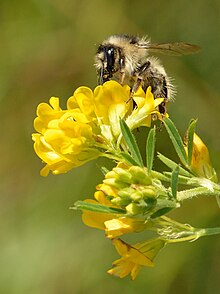Sickle clover
| Sickle clover | ||||||||||||
|---|---|---|---|---|---|---|---|---|---|---|---|---|

Sickle clover ( Medicago sativa subsp. Falcata ) |
||||||||||||
| Systematics | ||||||||||||
|
||||||||||||
| Scientific name | ||||||||||||
| Medicago sativa subsp. falcata | ||||||||||||
| ( L. ) Arcang. |
The Medicago falcata ( Medicago sativa L. subsp. Falcata (L.) Arcang. ), Also Sickle alfalfa , sickle alfalfa or yellow alfalfa called, is a subspecies of the plant species alfalfa ( Medicago sativa L. ) of the genus of alfalfa ( Medicago ). It is common in Eurasia .
description

Appearance and leaf
The sickle clover is a perennial herbaceous plant that usually reaches heights of between 20 to 60 (to 120) centimeters. The branched stalk is seldom completely upright, usually ascending to prostrate. The stalked leaves are pinnate in three parts. The narrow elliptical, at the base wedge-shaped partial leaflets are between 5 and 20 millimeters long and 2 to 10 millimeters wide, sawn at the tip with a spike tip.
Inflorescence, flower and fruit
The flowering period extends from May / June to October. 3 to 20 flowers stand together in dense racemose inflorescences . The relatively small, hermaphrodite, zygomorphic flowers are 7 to 11 millimeters long. The petals are bright yellow in color. The seeds mature in about 7 to 15 millimeters long and 1.5 to 9 millimeters wide, straight or typically sickle-shaped legumes .
Chromosome number
The number of chromosomes is 2n = 16 or 32.
Occurrence
The range of Medicago sativa subsp. falcata extends from southern Europe, in the north to England , Denmark and the Baltic States , in the east it extends to west and central Asia . It is completely absent in the Central European lowlands as well as in the low mountain ranges and in the Alpine chains with lime-poor or lime-free rock; otherwise it occurs scattered in Central Europe . In the Alps it occurs generally at altitudes above about 1200 meters.
In Central Europe , it inhabits semi- arid grasslands , light shrubbery, bush fringes, embankments and the edges of dry forests. The sickle clover grows in sunny locations. The sickle clover often grows together with common horseshoe clover ( Hippocrepis comosa ) or seed saparsette ( Onobrychis viciifolia ). It is a character species of the Geranion sanguinei association, but also occurs in societies of the Festuco-Brometea class or the order Agropyretalia.
The sickle clover thrives best on dry, base-rich, deep, lime-rich, but rather poor loam or loess soils , but it also goes on sandy or gritty subsoil.
ecology
The Sicheklkee is a raw soil pioneer and deep-rooter. He is Nektarpflanze for Polyommatus damon , skipper and commons Bluebird .
Systematics
The subspecies Medicago sativa subsp. falcata (L.) Arcang. belongs to the species Medicago sativa L. in the section: Medicago within the genus Medicago . The sickle clover is often treated as a species ( Medicago falcata ) in Floren . The position within the Medicago sativa species complex is still being discussed (Tee Havananda 2010). Future research should show whether the rank of a species or subspecies is more appropriate.
There are at least two varieties:
- Medicago sativa subsp. falcata (L.) Arcang. var. falcata (Syn .: Medicago borealis Grossh. , Medicago difalcata Sinskaya , Medicago falcata L. (Basionym), Medicago falcata var. romanica (Prodán) O.Schwarz & Klink. , Medicago quasifalcata Sinskaya , Medicago romanica Prodán , Medicago tenderiensis Opperman ex Klokov )
- Medicago sativa subsp. falcata var. viscosa (Rchb.) Posp. (Syn .: Medicago falcata subsp. Glandulosa (WDJKoch) Greuter & Burdet , Medicago falcata var. Glandulosa W.DJKoch , Medicago glandulosa Davidov , Medicago procumbens var. Viscosa Rchb. (Basionym), Medicago sativa f. Viscosa (Rchb.) Urb . , Medicago sativa subsp. Viscosa (Rchb.) CRGunn )
literature
- Oskar Sebald, Siegmund Seybold, Georg Philippi (Hrsg.): The fern and flowering plants of Baden-Württemberg . tape 3 : Special part (Spermatophyta, subclass Rosidae): Droseraceae to Fabaceae . Eugen Ulmer, Stuttgart (Hohenheim) 1992, ISBN 3-8001-3314-8 .
Individual evidence
- ↑ a b c Medicago sativa subsp. falcata in the Germplasm Resources Information Network (GRIN), USDA , ARS , National Genetic Resources Program. National Germplasm Resources Laboratory, Beltsville, Maryland.
- ↑ a b c Erich Oberdorfer : Plant-sociological excursion flora for Germany and neighboring areas . 8th edition. Verlag Eugen Ulmer, Stuttgart 2001, ISBN 3-8001-3131-5 . Page 588.
- ↑ a b c d Dietmar Aichele, Heinz-Werner Schwegler: The flowering plants of Central Europe . 2nd Edition. tape 2 : Yew family to butterfly family . Franckh-Kosmos, Stuttgart 2000, ISBN 3-440-08048-X .
- ↑ Sickle clover. In: FloraWeb.de.
- ↑ Tea Havananda, E. Charles Brummer, Iván J. Maureira-Butler & Jeff J. Doyle: Relationships Among Diploid Members of the Medicago sativa (Fabaceae) Species Complex Based on Chloroplast and Mitochondrial DNA Sequences. In: Systematic Botany , Volume 35, Issue 1, 2010, pp. 140-150. doi : 10.1600 / 036364410X493340
Web links
- Sickle clover. In: FloraWeb.de.
- Sickle clover . In: BiolFlor, the database of biological-ecological characteristics of the flora of Germany.
- Profile and distribution map for Bavaria . In: Botanical Information Hub of Bavaria .
- Medicago falcata L. In: Info Flora , the national data and information center for Swiss flora . Retrieved November 15, 2015.
- Distribution in the northern hemisphere from: Eric Hultén, Magnus Fries: Atlas of North European vascular plants , 1986, ISBN 3-87429-263-0 .
- Thomas Meyer: Data sheet with identification key and photos at Flora-de: Flora von Deutschland (old name of the website: Flowers in Swabia )
- Wanted poster with photos.
- Data sheet with photos.
- Photo.



